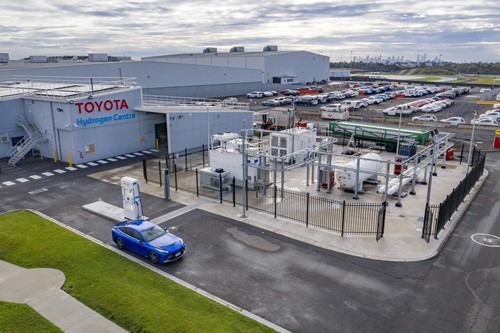News
Toyota unveils Victoria's first commercial H2 refueling facility

Toyota has commissioned Victoria's first commercial-grade, permanent H2 production, storage and refueling facility at its former manufacturing site at Altona in Melbourne's west.
Toyota Australia President and CEO Matthew Callachor said the Toyota Hydrogen Centre was built to showcase the benefits of hydrogen fuel cell technology as part of its commitment to developing sustainable technologies for future mobility and energy needs.
"The infrastructure which is being commissioned at this new Toyota facility will not only progress the deployment of hydrogen vehicles, which can make a major contribution to helping our transport sector navigate Australia's energy transition, but it will also serve as a beacon to other companies looking to invest in hydrogen transport technology," said Dr Patrick Hartley, CSIRO Hydrogen Industry Mission lead.
Sustainably produced hydrogen is the core element to fuel vehicles like the Toyota Mirai FCEV, an advanced fuel cell electric vehicle that produces no CO2 emissions, requires no battery recharging and has a range of 650 km.
The Toyota Mirai has been sold in markets in Japan and US for the past seven years but the greatest challenge to the broad-scale introduction of fuel cell electric vehicles in Australia has been a lack of refuelling infrastructure and the Toyota Hydrogen Centre is an important step in addressing this challenge.
Together with the hydrogen production, storage and refuelling facility, the Toyota Hydrogen Centre also incorporates an Education Centre to provide information on how hydrogen fuel cells work and the benefits to society, helping to dispel any myths around the safety and use of hydrogen as a fuel.
Hydrogen is produced on site by a 200kW electrolyser that uses electricity to split water into hydrogen and oxygen components and has the capacity to produce up to 80kg of hydrogen per day.
Power for the electrolyzer is drawn from a combination of an 87 kW solar array, a 100 kW battery storage, and mains grid, depending on what's available at the time.
The hydrogen is then stored in a bank of storage tubes at medium and high pressure to be able to refuel both the fuel-cell forklifts that Toyota uses in other parts of the Altona complex and hydrogen FCEVs, like the new Mirai FCEV.

